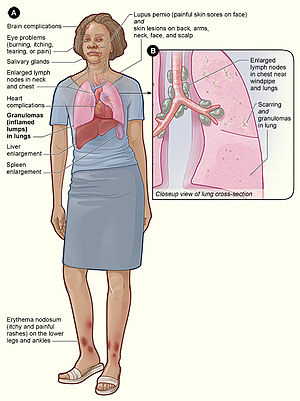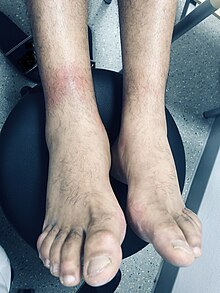Löfgren's Syndrome
| Classification according to ICD-10 | |
|---|---|
| D86.8 | Sarcoid at other and combined sites |
| ICD-10 online (WHO version 2019) | |
Löfgren's syndrome is the name for the acute form of sarcoid and affects around one third of all cases. The disease is named after the first person to describe it, Sven Halvar Löfgren .
Löfgren's syndrome (stage I of sarcoid) is characterized in typical cases by the triad of symptoms :
- bihiläre lymphadenopathy (usually symmetrical enlargement of hilar - lymph nodes ) in all cases (100%)
- Polyarthritis (with increased involvement of the ankle joints ) 80%
- Erythema nodosum (nodular subcutaneous inflammation) 70–80% of cases
Polyarthritis and erythema often occur together, but only one of the two symptoms can occur. Less common are:
- Liver involvement
- Inflammation of the eye ( iridocyclitis , conjunctivitis )
- Meningeal irritation (symptoms reminiscent of meningitis )
- Myocarditis
Laboratory examination:
- Accelerated blood sedimentation
- Leukocytosis , eosinophilia
- increased alpha and beta globulins
- no evidence of tuberculosis pathogens
- In the acute form, there is often no increase in the angiotensin conversion enzyme (ACE), which is typical for the chronic form.
Common misdiagnoses:
- Rheumatic fever
- flu
- Lymphangitis
- allergy
- tuberculosis
- Hodgkin's disease
root cause
It mainly affects patients between the ages of 20 and 30, with women predominating. There is a seasonal variation with peaks in spring and autumn. The disease is caused by an overreaction of the immune system, the trigger of which is unknown.
Symptoms
Löfgren's syndrome is a highly acute clinical picture with a sudden onset. It often begins with irritation of the respiratory tract that resembles an infectious disease, as well as rheumatic complaints. In 70–80% of cases there is coarse, nodular reddening of the skin, erythema nodosum , which is extremely painful on pressure, overheated, reddened and swollen. They are an expression of an acute inflammation of the subcutis (subcutaneous tissue ) with a diameter of up to 10 cm. Affected body regions are mostly lower legs, feet and hands. General symptoms such as fever , fatigue, myalgia and flu-like infections can also be observed.
Diagnosis
X-rays of the lungs, lung function tests and a bronchoscopy with tissue removal ( biopsy ) are used for diagnosis .
therapy
In stage 1 only controls and non-steroidal anti-inflammatory drugs such as acetylsalicylic acid , ibuprofen or diclofenac are used. Corticoids are used in stages 2 and 3 of sarcoid ; in severe cases, treatment with cytostatics can be attempted.
The prognosis is usually good, with spontaneous healing within one to two years in 80–90% of cases. As a rule of thumb, the younger the patient and the more acute the course, the better the prognosis.
literature
- Eric Haus, Steffen Gross: Internal Medicine (= White Series. Volume 4). House and Gross, Völklingen 1995, DNB 947072594
Web link
- Contribution to rheuma-online

